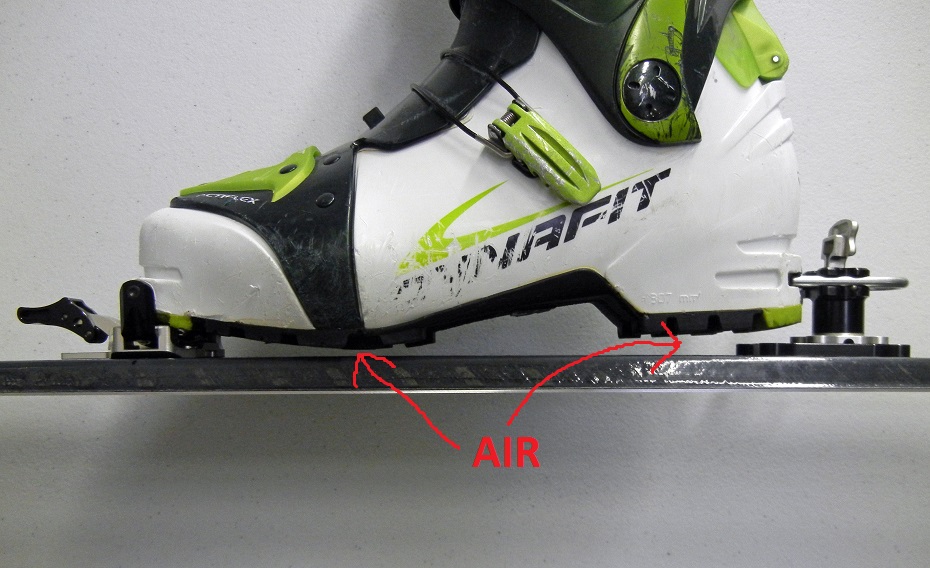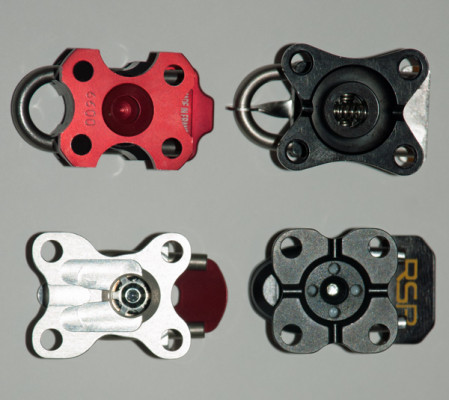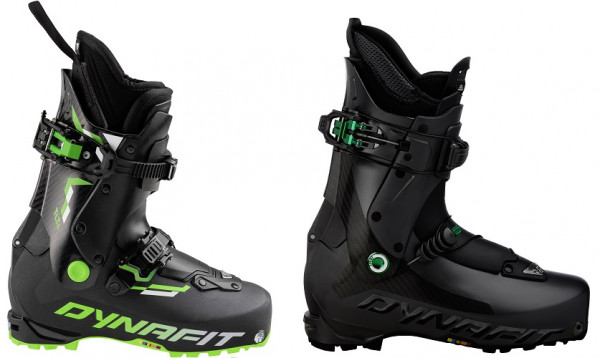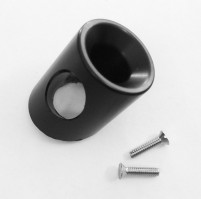1/5/2020 Binding Pin Heights
Alpine skiers can be surprised to learn that tech bindings essentially suspend your boot in the air above your ski. Your weight is not resting on the ski at all, but rather is supported by metal pins that insert into reinforced holes found on Dynafit compatible ski boots. It can be important to consider just how far off the deck your toes and heels are floating, since this can affect how your weight is balanced over your skis.

The height of the pins that hold your boots is not typically published by binding manufacturers. However, this can be good information to know if you are trying to determine the angle of ramp between your ski and ski boot. As such, we took to measuring them. See below for a list of pin heights in millimeters for common tech bindings, accurate to within one millimeter:
| Binding | Toe Height | Heel Height | Delta |
| ATK Revolution | 29 | 29 | 0 |
| ATK Revolution Brake | 29 | 28 | -1 |
| ATK SL World Cup | 30 | 29.5 | -0.5 |
| ATK Trofeo | 30 | 30 | 0 |
| ATK Trofeo Brake | 30 | 28 | -2 |
| ATK Kuluar | 30 | 41.5 | +11.5 |
| ATK Haute Route | 30 | 36.5 | +6.5 |
| ATK Haute Route Plus (2024+) | 33.5 | 36.5 | +3 |
| ATK Haute Route Plus (2023) | 30 | 36.5 | +6.5 |
| ATK Candy | 33.5 | 41.5 | +8 |
| ATK Crest (2024+) | 33.5 | 45 | +11.5 |
| ATK Crest (2023-) | 30 | 41 | +11 |
| ATK Crest AP | 30 | 45 | +15 |
| ATK V-Crest | 33.5 | 41.5 | +8 |
| ATK RT 8/10 Evo | 30 | 44.5 | +14.5 |
| ATK RT 11 Evo | 34.5 | 44.5 | +10 |
| ATK C-Raider | 33.5 | 43.5 | +10 |
| ATK Raider (2020+) | 31.5 | 43 | +11.5 |
| ATK Raider SL | 33.5 | 45 | +11.5 |
| ATK Raider Evo | 33.5 | 44.5 | +11 |
| ATK Freeraider Evo | 37.5 | 44.5 | +7 |
| ATK Freeraider | 31.5 | 43 | +11.5 |
| Atomic Backland | 30.5 | 39 | +8.5 |
| Atomic Summit | 33.5 | 41 | +7.5 |
| BD Helio 110 | 30 | 29.5 | -0.5 |
| BD Helio 145 | 30 | 30.5 | +0.5 |
| BD Helio 180 | 30 | 36.5 | +6.5 |
| BD Helio 200 LT | 30 | 31.5 | +1.5 |
| BD Helio 200 | 30 | 36.5 | +6.5 |
| DPS L10 | 30 | 36.5 | +6.5 |
| DPS R10 | 35 | 43 | +8 |
| DPS H10 | 34 | 44.5 | +10.5 |
| DPS R14 | 35.5 | 43.5 | +8 |
| Dynafit Blacklight | 30.5 | 39.5 | +9 |
| Dynafit DNA / Mezzalama | 30 | 33.5 | +3.5 |
| Dynafit Low Tech Race | 28.5 | 28.5 | 0 |
| Dynafit LTR 105 | 30 | 30.5 | +0.5 |
| Dynafit Radical ST/FT | 35.5 | 50.5 | +15 |
| Dynafit Radical ST Alu | 37 | 53 | +16 |
| Dynafit Radical 2.0 | 38 | 51 | +13 |
| Dynafit Ridge | 37.5 | 44.5 | +7 |
| Dynafit Rotation 7 | 38 | 50.5 | +12.5 |
| Dynafit Rotation 10/12 | 38 | 51 | +13 |
| Dynafit Speed/Speedfit | 31 | 38.5 | +7.5 |
| Dynafit Seven Summits+ | 33.5 | 45.5 | +12 |
| Dynafit Speed Turn | 28.5 | 44 | +15.5 |
| Dynafit Speed Turn 2.0 | 30.5 | 45 | +14.5 |
| Dynafit Speed Radical | 30.5 | 45 | +14.5 |
| Dynafit Speed Superlite | 28.5 | 31 | +2.5 |
| Dynafit Superlite 150 | 30 | 36 | +6 |
| Dynafit Superlite 2.0/175 | 28.5 | 36 | +7.5 |
| Dynafit TLT Expedition | 28.5 | 31.5 | +3 |
| Dynafit Vertical ST | 33.5 | 49.5 | +16 |
| Fritschi Tecton | 41.5 | 51.5* | +10 |
| Fritschi Vipec | 41.5 | 51.5 | +10 |
| Fritschi Xenic | 32.5 | 47 | +14.5 |
| G3 Zed 9 / 12 | 39 | 43 | +4 |
| G3 ION | 40.5 | 51.5 | +11 |
| Grizzly GR98/Olympic | 27.5 | 26.5 | -1 |
| Hagan Boost | 34 | 43.5 | +9.5 |
| Hagan Core | 31.5 | 42.5 | +11 |
| Hagan Core Evo | 31.5 | 45 | +13.5 |
| Hagan Core Pro | 31.5 | 43.5 | +12 |
| Hagan Pure | 30 | 41 | +11 |
| Hagan Pin Up Evo | 30 | 44.5 | +14.5 |
| Hagan Ride | 31.5 | 36.5 | +5 |
| Hagan ZR / Ultra | 28 | 27.5 | -0.5 |
| Kreuzspitze EL | 29 | 35 | +6 |
| Kreuzspitze SCTT | 28.5 | 28 | -0.5 |
| Kreuzspitze RS | 29 | 28 | -1 |
| Kreuzspitze GT | 29 | 28.5 | -0.5 |
| Kreuzspitze GT 2.0 | 29.5 | 28.5 | -1 |
| La Sportiva RSR | 28 | 28.5 | +0.5 |
| Marker Alpinist | 34 | 36 | +2 |
| Marker Cruise | 34 | 48.5 | +14.5 |
| Marker Kingpin | 41 | 50.5* | +9.5 |
| Plum 99 | 30.5 | 28 | -2.5 |
| Plum 120 | 30.0 | 28.5 | -1.5 |
| Plum 135 / 145 | 27.5 | 29.5 | +2 |
| Plum 150 | 30.5 | 31.5 | +1 |
| Plum 165 | 27.5 | 31 | +3.5 |
| Plum 170 | 30.5 | 35 | +4.5 |
| Plum Oazo | 30.5 | 34.5 | +4 |
| Plum Pika | 30.5 | 39 | +8.5 |
| Plum WEPA | 31 | 42.5 | +11.5 |
| Plum Caribou / Karibou | 40 | 47.5 | +7.5 |
| Plum Guide | 29.5 | 47.5 | +18 |
| Plum Summit | 40 | 53.5 | +13.5 |
| Plum Yak | 39 | 47.5 | +8.5 |
| PG U77 | 28.5 | 32.5 | +4 |
| RC1 by PG | 24 | 30 | +6 |
| Salomon MTN | 30.5 | 39 | +8.5 |
| Salomon Summit | 33.5 | 41 | +7.5 |
| Ski Trab Gara Titan | 31 | 30 | -1 |
| Ski Trab Titan Brake | 31 | 31 | 0 |
| Ski Trab Titan Vario | 31 | 34 | +3 |
| Ski Trab Titan Adjustable | 35.5 | 42.5 | +7 |
| Ski Trab Titan Vario.2 | 35.5 | 44 | +8.5 |
| Ski Trab TR Race | 29.5 | 30 | +0.5 |
| Ski Trab TR Adjustable | 29 | 35 | +6 |
| Ski Trab TR-2 | 36 | 44* | +8 |
| Slatnar ST Touring | 29.5 | 40 | +10.5 |
| Tyrolia Almonte PT | 31.5 | 42 | +10.5 |
* Estimate of where heel pins would be.
The key number in the above table is pin height delta found in the last column. This number is an indication of how much higher your heel is than your toe. Higher deltas can shift your weight forward on the ski, which can be an unnatural feeling for some skiers. Somewhat counterintuitively, those skiers tend to end up in the “back seat” since their bodies naturally compensate with additional knee flex and backwards lean. While this is an OK position in certain situations, overall it causes poor control, unnecessary knee strain, and tired quads.
We would be remiss to not mention adjustment plates in this discussion. A tool for skiers with a quiver of boots, these plates are mounted under the toes (uncommon) and heels (common) of race bindings to provide some fore/aft adjustability. Since they are not zero inches thick, they will directly alter the pin heights of the bindings mounted on them. Here are the thicknesses of some popular adjustment plates, which are added to the binding pin heights:
| Adjustment Plate | Thickness |
| BD Helio | 5.5mm |
| Dynafit | 5mm |
| Hagan | 5mm |
| Kreuzspitze | 5.5mm |
| La Sportiva | 5mm |
| Plum | 6.5mm |
Now before you go calculating millimeters and adding shims, take a step back to realize there is no “correct” pin height delta. Alpine ski racers are used to aggressive postures and tend to prefer driving from the front seat. Casual powder hounds often like their weight back a bit as they surf through fluff with their tips high. Cross-country skiers tend to prefer an upright stance, and don’t want to be nudged in any direction. Lou Dawson established a baseline goal for himself to be roughly +12mm delta based on early Dynafit binding models.
We think you shouldn't worry too much about a few millimeters. However skier balance is additionally affected by other variables, such as the forward lean of boot cuffs, ramp built into the boot sole, and stock or aftermarket insoles. If all of these variables point in the same direction, it is easy for your balance to get out of whack. This can often be a relatively straightforward fix that involves mounting shims or toe plates under your bindings. If you’re looking for advice on your particular setup, please send us a message.
This article was originally published on 3/31/2014 and was last updated on 1/5/2020.Comments
Great info on pin heights! Do you know the heel piece pin height of the dynafit superlite c-one binding (the one with +/-12mm adjustment and 4 bolt baseplate)? I can't find any reliable data on it anywhere!
Thanks,
James
Counter intuitively, the steeper the forward ramp angle the more one has to compensate to get out of the backseat. This is assuming that the flex and fitting of the boot allows one to flex their ankle functionally while in the buckled boot. Ankle flex and ramp angle work together.
So, point is, the more data one has to work with the better the results with fewer hiccups and wasted time. Also the more we all step up to the fact that the ski industry needs to do a lot more research on the human/ski boot/binding interface the sooner they will get the message and step up as well. Publishing binding pin heights is a step in that direction. Information like this should be readily available from the manufacturers but, is not. Why is that?
I looked long and hard for good information on functional boot fitting and found The Skier's Manifesto website/blog by David Macphail is by far the best source for real information and answers. Web address is skimoves.me . David has been researching this subject for over 45 years and is still at it and still finding new things such as - ramp angle for some people may be much lower than previously determined. As low as 1.2 degrees in some cases and that it can vary individually but, is never more than 2.8 degrees.
Thanks,
Herb

1/16/2020
Hole Pattern Recognition










